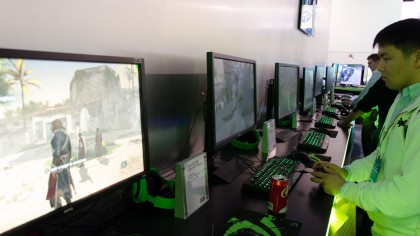AMD on Mantle: We want our graphics API to become the industry standard
But Nvidia would need to get on board

Mantle has been a story of fits and starts. But with this week's release of the Catalyst 14.1 beta driver and a pair of game patches, AMD's vision for a low-level, graphics-boosting API is finally starting to take flight.
There's plenty of work to be done - the driver is still in beta, after all - but with its release, the effects of Mantle can be implemented by anyone who likes (albeit with some limitations).
Mantle's benefits are promising, but right now its dependence on Graphics Core Next (GCN) architecture keeps it well within AMD's gates. With the company's talk of Mantle improving PC gaming not only for game makers, but for those who play them too, we wanted to know whether AMD would ever open the API to other companies, including its fiercest rivals.
The answer, it turns out, is yes.
Mantle, or something like it
AMD told TechRadar that it'd be willing to make Mantle, or an API based on it, available across the industry. Even, the company said, if it means Mantle is adopted by competitors like Nvidia.
"Mantle for now is straight up in a closed ecosystem, a closed beta, which you have to do in a complicated project like this to get it off the ground. It's us and a few key game developers," Robert Hallock, technical communications, AMD Graphics & Gaming, told us in a recent interview.
"After that phase is done, we do hope that Mantle becomes an industry standard. We'll be releasing a public SDK later this year, and hope that others adopt it. If they don't adopt it itself, then we hope they adopt APIs similar to it that become an industry standard for PC gaming."
Sign up for breaking news, reviews, opinion, top tech deals, and more.
How open can you go?
It's a nice sentiment, but does that mean AMD is willing to allow an entity traditionally viewed from behind enemy lines make use of Mantle?
"It's hard to say," Hallock said. "If we want it to be an industry-wide API or inspire an industry-wide API, that would mean adoption from Nvidia in some way, shape or form. I can't speak from an architectural level what that would require of them to change."
"But for the good of gamers, [we] would want one ultimate specification that is either Mantle itself or one similar to it. As Highlander said, 'There can only be one.'"

We asked Nvidia for its thoughts on Mantle and whether it would ever consider adopting the API, but were told that since Mantle isn't open and the company has never seen it, it couldn't comment.
Hallock explained that while it's currently dependent on GCN, Mantle "utilizes a certain level of meaningful hardware abstraction that could eventually allow it to be applicable to other architectures."
"Such applicability," he continued, "is necessary in an ecosystem we hope to grow as an industry standard in the years ahead."
PC thumbprint
AMD has maintained that Mantle will succeed because it was built with the in-put of game developers who wanted to nab better graphics performance with minimal overhead from the machines running their titles.
Hallock relayed some of the feedback developers have had around Mantle, and while he revealed it takes devs longer to bring up a game using the API, the perks quickly become evident.
"It's sort of a simpler, more obvious API with really robust error and obstruction tools," he said. "[Developers] can see what's going wrong [as they develop a game], and it saves time for them."
DICE was the first game dev on the good ship Mantle, but Oxide, Cloud Imperium, and Eidos-Montreal have since jumped on board. Hallock couldn't name future game developers who will join the Mantle march, but said AMD expects more will be announced as the year goes on.

And though a Mantle-enabled Battlefield 4 was supposed to be the API's big coming out party late last year, a hold-up on EA's end pushed back the release.
"We were all a little disappointed," Hallock said of the BF4 delay. "I think we all wanted it to come out in December, but software is a fickle thing. It's unfortunate, but in the grand scheme it's not a big blow. People will be happy and appreciate the extra time that was invested. It is what it is for us."
EA pushed out its Mantle renderer for BF4 last week, and in announcing the release, Frostbite Technical Director Johan Andersson wrote that thanks to the API, "we've significantly reduced CPU cost in our rendering, efficiently parallelized it over multiple CPU cores and reduced overhead in many areas," in addition to improvements to the GPU workload.
That, it seems, would be music to Hallock's ears.
"We hope to put our thumbprint on the industry to show that these lower level APIs for mid-range CPUs is the right way to do it on the PC," he said during our interview. Time, and more games, will tell if that thumbprint sticks.

Michelle was previously a news editor at TechRadar, leading consumer tech news and reviews. Michelle is now a Content Strategist at Facebook. A versatile, highly effective content writer and skilled editor with a keen eye for detail, Michelle is a collaborative problem solver and covered everything from smartwatches and microprocessors to VR and self-driving cars.